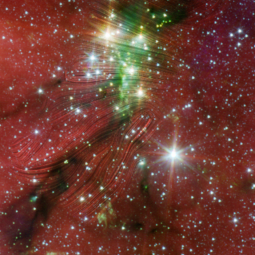By Thushara Pillai and Joan Schmelz
Paper:
Magnetized filamentary gas flows feeding the young embedded cluster in Serpens South
Pillai, T.G., et al., 2020,
Nat Astron
(2020).
The vast space between stars is home to filamentary gas and dust features that appear to play a major role in channeling mass into young clusters where stars can form. These formation processes are driven by a complex interplay of several fundamental forces including turbulence, gravity, and the magnetic field. In order to get an accurate description for how dense clusters of stars form, astronomers need to pin down their relative roles. Turbulent gas motions as well as the mass content of filaments (and therefore gravitation force) can be gauged with relative ease. However, the signature of the interstellar magnetic field is so weak – about 10,000 times weaker than Earth’s magnetic field – that measuring the field strengths in filaments is a formidable task.
Fortunately, a small fraction of the interstellar mass is composed of dust grains that tend to align perpendicular to the direction of the magnetic field. As a result, the light emitted by these grains is polarized, and this polarization can be used to chart the magnetic field directions. Recently, the Planck satellite produced a highly sensitive all-sky map of the polarized dust emission at wavelengths smaller than 1 mm. This provided the first large-scale view of the magnetization in interstellar filamentary features and their environments.
Studies done with Planck data found that filaments are not only highly magnetized, but they are coupled to the magnetic field in a predictable way. The orientation of the magnetic fields is parallel to the filaments in low-density environments and perpendicular in high-density environments. This result implied that magnetic fields are playing an important role in shaping filaments.
But this observation also points toward a problem. In order for stars to form in gaseous filaments, these filaments have to lose these magnetic fields. When and where does this happen? With an order of magnitude higher angular resolution than Planck, the HAWC+ instrument, a polarization-sensitive detector onboard SOFIA, is now able to resolve the regions where the filamentary magnetic field becomes less important.
HAWC+ observations were obtained to study the role of magnetic fields in Serpens South Cluster, a young, nearby star forming region that sits at the center of a network of dense filaments. HAWC+ confirmed the trend seen in the lower resolution – that the magnetic field is parallel to low-density gaseous filaments and perpendicular at higher densities.
The finer resolution of HAWC+, however, also revealed a twist to the Planck story. In the most opaque parts of certain filaments, the observations show that the magnetic field is once again aligned. This transition appears to result as the magnetic field succumbs to the strength of the gas flow, allowing gravitational collapse and cluster formation to occur even in the presence of relatively strong magnetic fields. Additional observations and modeling will be needed to understand the magneto-hydrodynamic forces that govern the complex processes involved in star formation.
Also see this Astrobites summary.
